
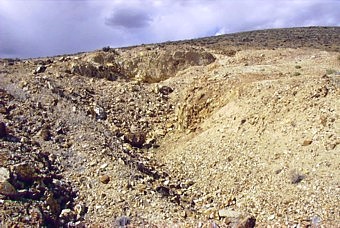
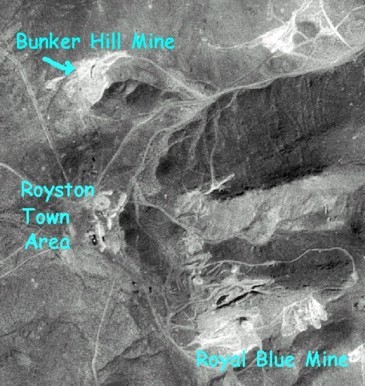
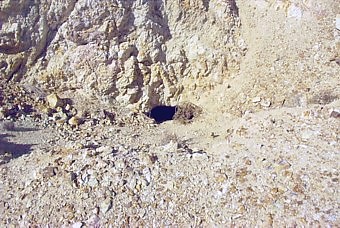
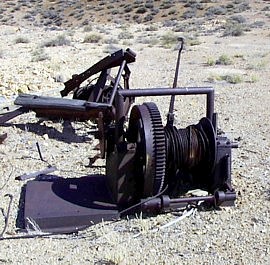
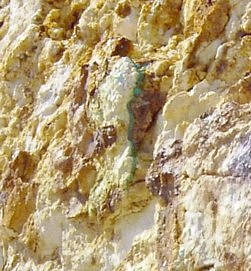
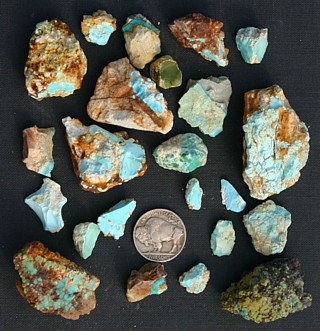
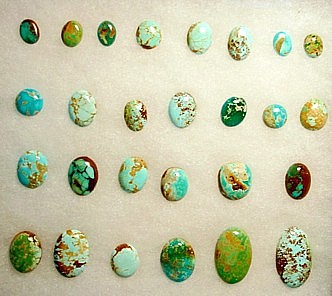
This photo shows a fine pendant of natural Royston turquoise showing fine blues with smoky green. To see more of our turquoise jewelry, Click Here.
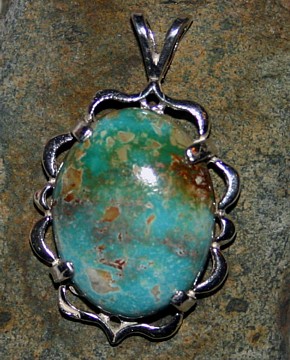
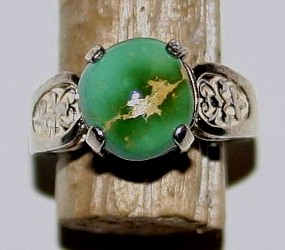

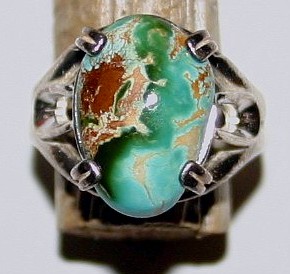
The Blues of Bunker Hill
 |
|
 |
The Bunker Hill Turquoise mine at Royston is located in Esmerelda County, about 25 miles NW of Tonopah, Nevada. Royston has been one of the most productive turquoise districts in all of Nevada, and turquoise was mined here on a small scale by local Indian peoples for many years. The Royal Blue, the largest property, was discovered by local prospectors in 1909. However, our property, the Bunker Hill, mine is small by comparison to the major mines in the Royston area. It was first discovered in 1927 by Bert Kopenhaver. The initial work was a shaft that was sunk down on the turquoise bearing zone. The present surface workings are the result of extensive bulldozer work. Dozer cuts have nearly completely covered the older underground workings. |
| The Bunker Hill mine is a little more than 1/3 mile north of the Royal Blue Mine, the most productive mine in the Royston area. The mine is located at the edge of a broad valley that spreads out to the west. This is an aerial shot showing the central part of the Royston Turquoise District. There are a number of other turquoise mines and prospects beyond those shown in the photo - they are located both to the north as well as to the south. The Royston town area has not been occupied for many decades. The Royston District is covered by a number of mining claims and is currently being explored for gold deposits, which are found near turquoise deposits in many places in Nevada. The Bunker Hill is the only turquoise mine at Royston that is currently being worked. |
 |
 |
Bert and his partner Roy Palfreman took out about $30,000 in turquoise as a part of their initial work and then sold out to the company that owned the nearby (and larger) Royal Blue mine. The new owners continued Bert and Roy's work and took out another $75,000 worth of turquoise. The Royal Blue company converted the small underground mine into a small open pit. The small black hole in the middle of this photo is one of the few openings leading into the old part of the Bunker Hill mine. This tiny entrance is covered by dozer tailings and is too small for even a child to enter. |
| The old underground part of the mine cannot be entered as the material from the bulldozer workings covers the old entrances. This photo shows the old power hoist Bert and his partner used in pulling the rock up out of the mine when the work was being done underground. The cable on the drum was attached to an iron barrel that held the rock as it was hoisted up to the surface. Many bull-dozer trenches were dug around the Royston area in the 1960s and 1970s, but only a small amount of this type of work was done at the Bunker Hill site. |
 |
 |
The turquoise bearing zones follow small faults and fractures in the rock, which is heavily altered to a white to light brown color. The host rock seems to have originally been a fine grained volcanic porphyry, though it so much changed it is hard to tell what it once was. The turquoise forms in small cracks in the rock. Here, along the exposed wall of the Bunker Hill open pit, a small veinlet of deep blue-green turquoise fills what was once a narrow crack. This is why most turquoise is so thin - however, the Royston area does also produce some much thicker material. The piece shown in this photo is about 1/4 inch thick and almost 3 inches long. |
| The turquoise bearing zone is about 6 feet wide and extends in an east-west direction across the 1500 foot length of the claim. There may be several parallel turquoise zones. It has been exposed on the surface for nearly half that width. Many of the turquoise zones at Royston, including those at the Royal Blue, tend to go in an east-west orientation. The Bunker Hill mine produces good, hard turquoise ranging from a light blue to deep royal blue color. A large percentage of the turquoise that comes from this property is hard enough to be classified as gem quality material. The rough from the Bunker Hill mine is sawed up and cut into cabochons (smooth polished stones, as is typical for turquoise). |
 |
|
Both blue and green colored turquoise are commonly found at the Bunker Hill property, including some stones in which both colors appear (this is a typical characteristic for a good percentage of Royston turquoise). The mine also produces some nice spiderweb matrix material as well. Here is a selection of typical cut gems that shows some of the range of fine gems that come from the Bunker Hill mine. This photo shows that the mines does produce just a little bit of everything in the way of gem quality turquoise material. All of these gems are hard and solid and feature a good deep polish - some are even translucent. The examples also show some of that nice spiderweb matrix material as well. |
|
This photo shows a fine pendant of natural Royston turquoise showing fine blues with smoky green. To see more of our turquoise jewelry, Click Here. |
 |
 |
The Bunker Hill mine and the Royston area in general is considered by many as one of the "classic" western turquoise locations, and Royston Turquoise has been featured in a number of publications. At the present time, we are only re-working the old mine dumps, but so far this has produced sufficient turquoise to meet our needs. |
| This is a bird's eye view of our camp spot at Royston when we are working the Bunker Hill mine. It is a nice level spot to park the trailer. Although there is a power line that goes through here, there is no useable power, no water and no other facilities for many miles. The western part of the Bunker Hill workings are the light colored materials on the edge of the photo at the upper right. We acquired the Bunker Hill mine in the Spring of 2005, and continue to work it on a small scale. It yields some nice turquoise in blue and green colors very typical of what has been found at Royston over the years. |
 |
 |
Here's another classically colored piece of blue and green turquoise from Royston. If you are interested in purchasing some of the turquoise from the Bunker Hill mine, check the links shown below for the rough and finished gems we have available for sale. |